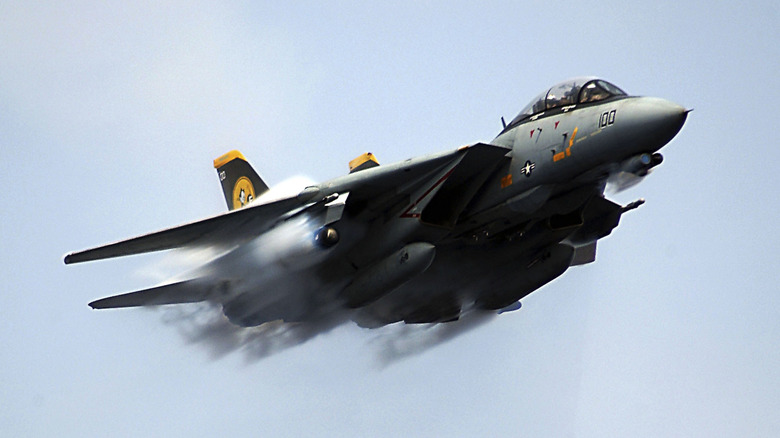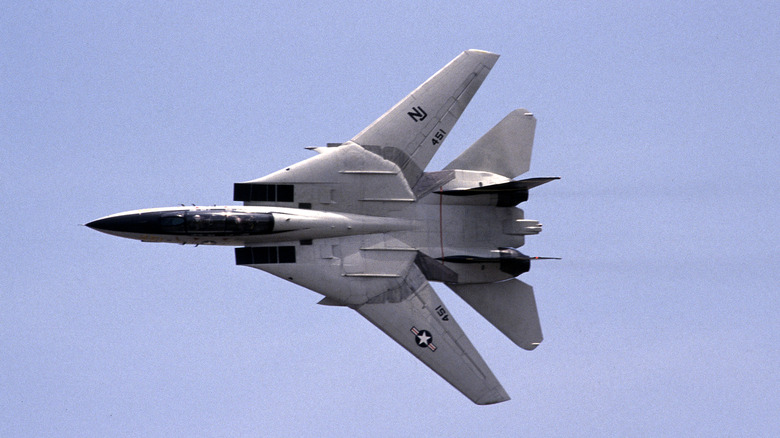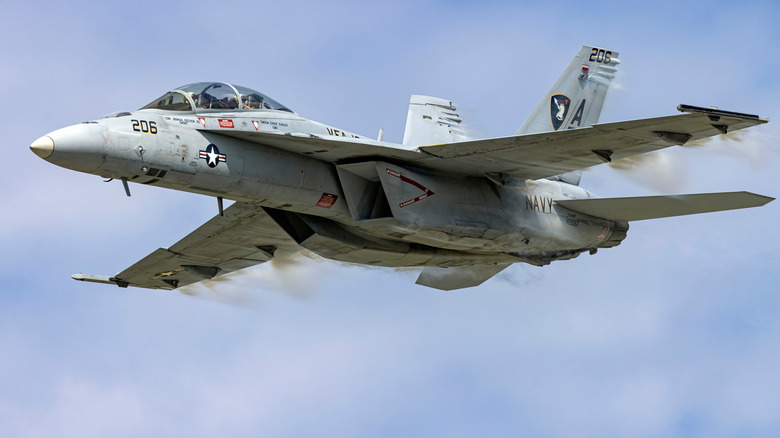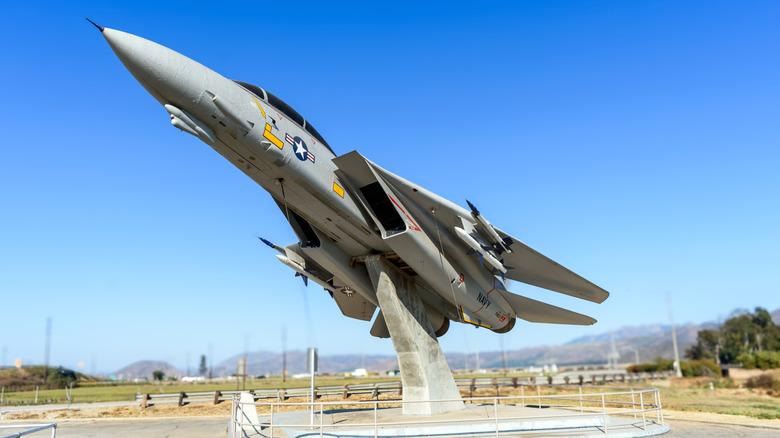Why The US Navy Retired The F-14 Tomcat Fighter Jet
The Grumman F-14 Tomcat is probably the most recognizable fighter jet from the 20th century thanks to 1986's "Top Gun," starring Tom Cruise. The general public got to see the jet's variable sweep wing design–swept back for speed and pushed forward for cruising and landing–and maneuverability. What they didn't get to see was its ability to engage with enemies before they were even visible to the naked eye. The Tomcat could target rival aircraft over 90 miles away. The Tomcat was a Cold War boogeyman for rival nations, succeeding the F-4 Phantom. The Navy received its first order of F-14s in 1972, launching from carriers across the globe until it couldn't keep up with newer fighter jets like the F/A-14 Hornet.
There were no Tomcats in the air by the end of 2006 flying the American flag as the Navy retired its fleet. Unfortunately, the classic fighter couldn't keep up with the technology. Military contractors were rolling fighters like the F-117 Nighthawk stealth fighter and the B-2 Spirit stealth bomber off the assembly line during the Tomcat's service, which eventually led to the F-22 Raptor, the most advanced fighter jet with stealth technology just as good if not better than the two aforementioned planes. The F-14 would never be as stealthy.
No, the F/A-18 Hornet isn't anywhere near as stealthy as the Raptor, but it is more reliable than its predecessor and was significantly easier to land on aircraft carriers. Then there were the maintenance costs the Navy had to consider, which were piling up after every sortie.
The F-14 Tomcat wasn't as reliable and required too much maintenance
When you're flying faster than the speed of sound near 50,000 feet above the Earth's surface, pilots want an aircraft they can rely on. All of a jet's theoretical capabilities mean nothing if it can't get you home safe after a routine flight without encountering adversaries. There was an instance in 1973 when a Tomcat shot itself out of the air. A missile didn't release properly and instead launched debris into the engine's intake, forcing the pilot and his Radar Intercept Officer (RIO) to eject.
Furthermore, the F-14 was prone to what's called a flat spin, where the jet will spin while it's horizontal. The pilot and RIO have no choice but to eject when that occurs, but ejecting isn't very safe under those conditions. We've all seen "Top Gun" and remember the tragic scene where Goose dies in the same scenario. That was a very real possibility in real life.
Then there were the maintenance costs. One would think that an older aircraft wouldn't be as expensive to repair. However, when a plane requires anywhere between 30-60 hours of maintenance time for every hour of flight time, the bill gets to be a bit much. Virtually every vital component from the wing actuators to the radar electronics of the Tomcat continuously needed replacement. The Navy repurposed the platform in the late '90s to use the LANTIRN system, which allowed it to fly low to the ground at night to attack ground targets. Unfortunately, that did not solve the maintenance problem, and almost a decade later, the iconic Tomcat was decommissioned.
How the F/A-18 Hornet compares to the F-14 Tomcat
It's easy to compare the Hornet and the Tomcat to each other since the F/A-18 took over as the Navy's premier fighter jet. The Tomcat had a lot going for it. It was faster and had amazing long-range capabilities. Of course there's the obvious difference in their appearance. Where the F-14's wings would adjust, depending on the situation, the Hornet's wings are fixed; save for their ability to fold up when parked on an aircraft carrier. Not to mention the Tomcat was significantly larger than its successor.
While the Tomcat was a speed demon, going as fast as Mach 2.3, the F/A-18 Hornet performed better in a dogfight at slower speeds. This suited the Hornet just fine as it could only reach Mach 1.8 at most. It also proved better when its targets were closer, whereas the F-14 was superior at long range. Tom "Trots" Trotter, a former naval aviator with experience in both fighters, would call the Tomcat an analogue platform and the Hornet digital. He went on to tell the Fighter Pilots Podcast, "I think any Tomcat can give a Hornet a run, but you know, the Hornet's way better in the phone booth. The slow fight, gunning a guy, going a high angle of attack," when comparing the two jets.
He stressed more than anything in the interview that the Hornet was simply more reliable than the Tomcat. Now the Hornet has been completely overhauled into the Block III Super Hornet, bringing the platform into the 21st century.
The F-14 is still around
The F-14 Tomcat might be a relic of the past found primarily in museums these days, but it's still a go-to platform for one country. The Islamic Republic of Iran has maintained its own fleet of Tomcats since the late '70s. It's one $2 billion deal that the American government likely regrets to this day. At the time of the sale, Iran and America weren't on the outs with each other. The National Interest claims, "Analysts consider the F-14 to have been the equivalent of what the F-22 is today" which is to say it was one of the most advanced fighter jets at the time. Now, the US won't let any other nation buy the Raptor. At the time, America saw a Tomcat fleet in the region as a good thing because it would keep the Soviet Union in check.
Unfortunately, the 1979 Islamic Revolution happened and turned the tide for American/Iranian relations. Under the new leadership of the Ayatollah, Iran viewed America quite literally as Satan. Thanks to a network of spies and the black market, Iran has managed to keep its fleet of Tomcats operational for over four decades, forcing the Defense Department to destroy hundreds of F-14s. Of the original 79 Tomcats Iran received in the '70s, an estimated 24 remain operational as of 2022



